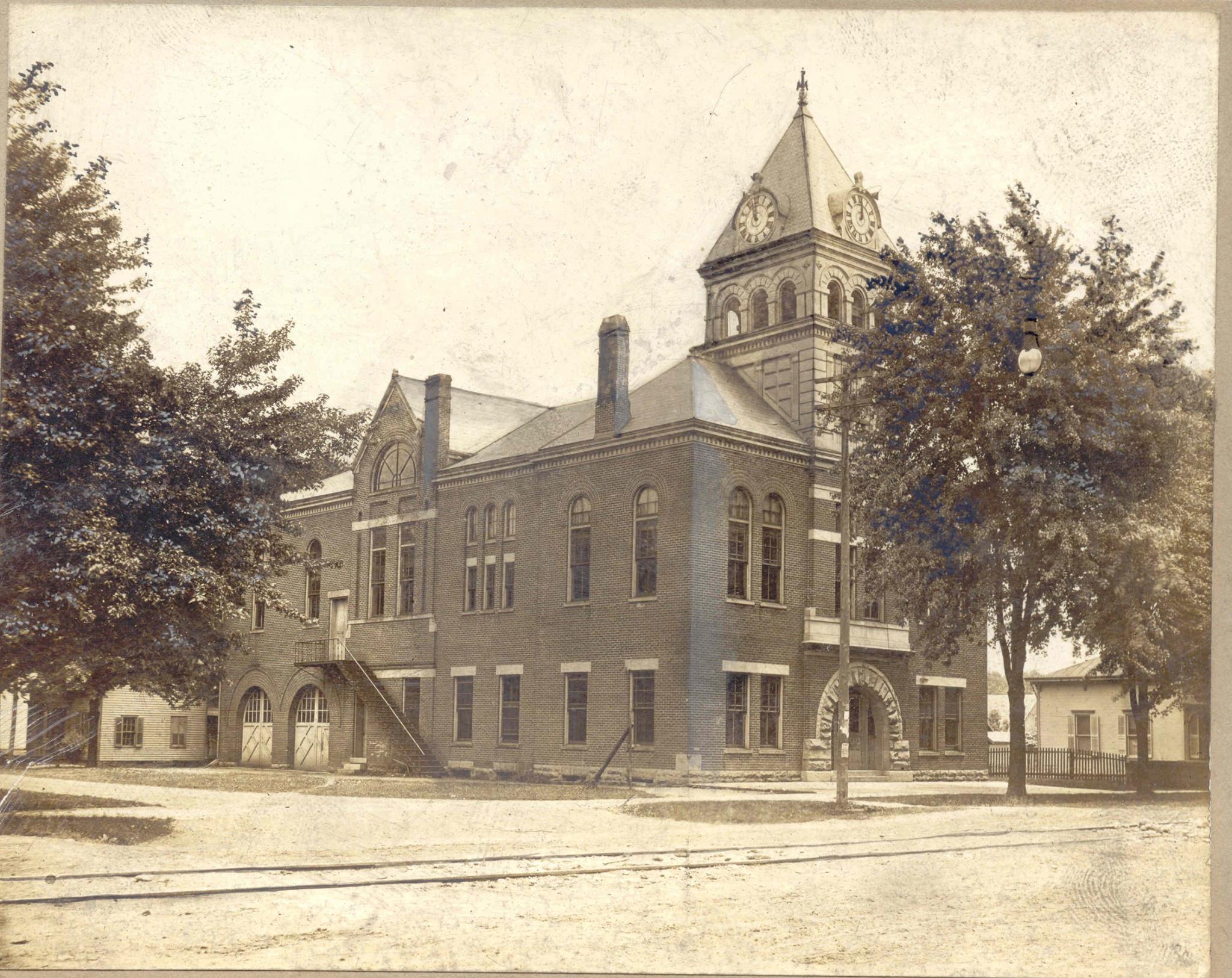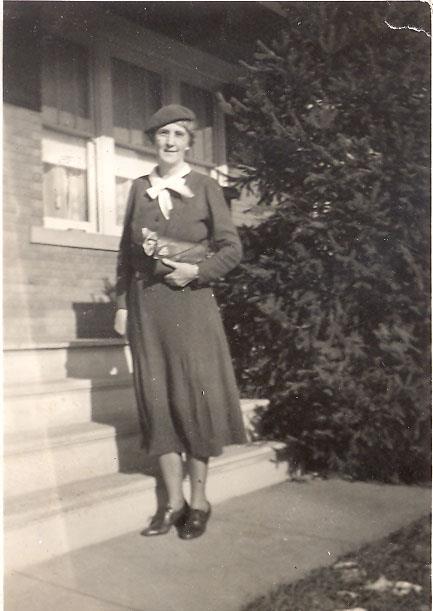
Richwood, Ohio was founded in 1832 by Mr. Phillip Plummer, his brother Thomas, who was a surveyor and John Flemming who was a nephew. They set out from Mt. Vernon, Knox County, Ohio, to go to the “rich woods,” a tract of land that Mr. Plummer purchased in Claibourne township, Union County, Ohio, 15 miles north of Marysville. A shanty was built for temporary shelter while a house was prepared for Mr. Plummer’s family to live in in the future. Plummer had determined that the town be called Richwood after the name of the tract which was so named because of the richness of its soil and the magnificent forest.
The first cabin was erected within the town plat and occupied by Dr. John P. Brookins and family. The cabin was a one-room building and was one story high with the logs scutched inside and out, clapboard roof and puncheon floor. There was an opening for one door without a screen and two windows without glass. A short time after Dr. Brookins moved in, Mr. Absalom Carney, a blacksmith, built himself a cabin on Main street. He was the second person in town. The next cabin was built by W.H. Frank, a 12 year old boy and his widowed mother. The boy lived with Mr. Baker Plummer, a brother of Phillip Plummer. When the boy turned 11, he went to live with Dr. John P. Brookins, with the recommendation of Baker Plummer.
The Doctor was a physician and druggist in Mt. Vernon. Frank lived with the Doctor and came with him to Richwood in 1832. The boy wanted to build a cabin for him and his mother. A man named Andrew, who lived 2 miles southwest of Richwood on Fulton Creek, helped him build the small cabin. In return, the boy offered the man his watch and pig that he received from Dr. Brookins when he was working at his drug store. The fourth cabin was built by Mr. Evans who engaged in shoe-making. He was the only businessman in town that brought any return for his wares. He sent shoe lasts (a shoe molding) to towns and cities, mostly to Dayton, Ohio. This was the first manufacturing establishment in Richwood.
Since its incorporation in 1835, Richwood has since grown to house many people and businesses. One of the oldest businesses is the Richwood Bank. In May 1876, The Bank of Richwood was established at 116 N. Franklin Street. Then, in 1906, the bank was incorporated with $35,000 and made its first name change to The Richwood Banking Company. In this year, the newly renamed bank also found a new location at the corner of North Franklin and East Blagrove, where it sits today.
Richwood houses over 2,000 people as of the 2010 census. The village remains a great place to live in Union County and it continues to grow.
More information about the founding of Richwood can be found in “A Voice From the Past” by W.H. Frank which is available at the library and can be bought as a free eBook at any major eBook retailer.
On June 19, 1882, a meeting was called at the Methodist Episcopal Church in Richwood to discuss the formation of a Richwood Library Association. P.R. Mills and J.D. Slemmons appointed a committee to solicit payment of membership fees. On motion, a committee of five was appointed to assist the President in selecting books for the library. Reportedly eighty people had subscribed to the association at one point. A membership fee of $3.00 was required to join; of which amount $2.50 was expended for the purchase of new books and book cases, and the additional 50 cents allowed for their share of the incidental expenses. Robert Smith served as librarian for the library association and also served as the chief editor and publisher for the Richwood Gazette. It is unknown how long the association lasted before an official public library was established. A list of books that the association maintained can be viewed here.
The Richwood Public Library board was formed and organized on January 26, 1915. The officers were: Rev. J.R. Lloyd, President; A.R. Klipstine, Vice-President; Mrs. C.E. King, Secretary; and Mrs. Charles Snowden, Treasurer. Other members included: Dr. Herman C. Duke, L.J. McCoy, and retired school superintendent, A. Oliver. Faced with the need to expand, the board found that the only rooms available were on the second floor of the Hastings Building on Franklin Street. The building was a three-story structure located in what is now the parking lot of the Richwood Banking Company. The Franz Millinery Shop occupied the first floor. The rent was set at $6 per month. Following discussion, the rooms were rented for 13 months at $75, and the board agreed to cut an opening for double doors and to paper the rooms. Mae Harriman was hired as the first official librarian of the Richwood Public Library.

On the afternoon of April 3, 1915, a book reception was held in the new library rooms. Rugs, a stove, a table, 150 books, and $12 in cash were donated. According to an article in the Richwood Gazette, it was reported that the library at the time had 635 books in the collection with 150 loaned from the State Library of Ohio. The library formally opened its doors on April 15, 1915. It also held subscriptions to popular periodicals and a large collection of magazines.
Legal documents verified the transfer and the sale of the Vaughn Building to the library in 1917. It appears that the library moved to this building which was located on East Blagrove Street behind the Richwood Banking Company building. A Mrs. Copp purchased the building for $859, with the stipulation that the library be housed on the first floor, and a museum on the second floor. The library board voted to purchase the property for $1,080.
By 1921, the library was flourishing. Miss Nora Lake was the librarian and earned a salary of $18 a month. The library board and its officers remained the same. A significant changed occurred, however, in 1925. The Ohio State Legislature placed libraries under the Department of Education. The Richwood Public Library became a "school district library." Geographically, the borders of the school district also determined the service area of the library. From 1925 onward, the local Board of Education assumed responsibility for appointing the library board members. Permission to go on the ballot to raise money for the building also had to be approved by the Board of Education. From this day to the present, the school and library have worked together to provide resources for students and teachers.
The library moved two more times until the library board felt the need to construct a new building. By this time, the funding of the library was provided by the intangible tax collected at the county level, some of which could be set aside for building purposes. A gift of residential property on East Blagrove was sold, and that money was added to the fund. Finding a suitable site for the new library posed a challenge. The only available site was a property on North Franklin Street that was formerly Benton's Garage. It was purchased by the board who discovered at a later date that it was unsuitable for a number of reasons. Fortunately, the board was able to sell the property, and, when the East Ottawa location became available (after an oil company decided not to purchase it for a filling station), it was unanimously agreed to be the best possible location.
The library board hired the architectural firm of Edwards, Burris, Lockwood of Marion to design the new building. James Hafer, a librarian from Newark, was hired to work with Mrs. McDaniel in the selection of library equipment and furnishings as well as to assist with the general layout. The location was purchased in July 1971 for $15,000. The bond levy, which came up for vote in the North Union School District, passed easily. The final cost of the building was $165,735. Furnishings costed around $22,326. The library was dedicated on September 22, 1974. The board members gave great consideration to the naming of the new building. Since the school district's boundaries were expanding, the library was serving a larger community. The board members, therefore, approved the new name: The Richwood-North Union Public Library.
To read more about the history of our library and the town of Richwood, the book "The Rich Woods of Union County" is available to check out at the library and can be bought wherever books are sold.
